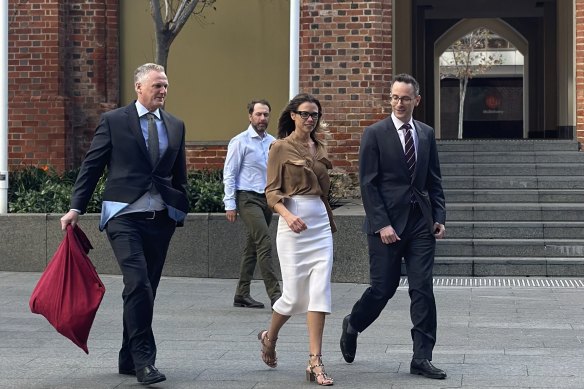Gina Rinehart inked “death warrant” deals for the lucrative trust fund her pioneer father left her four children, stripping it of its mining assets, wrestling back its stake in her company and leaving it “frozen in time”, a court has been told.
The extraordinary claims were levelled by Gina Rinehart’s two eldest children, John Hancock and Bianca Rinehart, on Wednesday, as part of a multibillion-dollar civil dispute over her company Hancock Prospecting’s Hope Downs iron ore mine royalties.

Bianca Rinehart arriving at WA’s Supreme Court on Wednesday.Credit: Jesinta Burton.
Bianca and John’s lawyer Christopher Withers, SC, said their grandfather Lang Hancock left his grandchildren a family trust housing more than $61 million in mining assets, including Hope Downs, when he died in 1992.
The plan was part of a 1988 agreement dictating the future of his estate, with Lang’s daughter left a majority shareholding in Hancock Prospecting and her children handed control of the trust.
But within two years the trust was in a “precarious” financial position, one Withers said Gina manufactured through a series of top-secret manoeuvres that left it beholden to her.
In the months after Lang’s death, Withers claimed the trust, of which Gina was still trustee, entered deeds taking on the debts of its subsidiary Hancock Resources to her company Hancock Prospecting and providing security over its mining assets.
According to Withers, it was also agreed that the trust’s tenements, a major source of its income, would be held for Hancock Prospecting, without any formal board approval, legal advice or commercial rationale.
Withers said the series of transactions were effectively a death warrant to the trust, strangling its access to funding, stopping its exploration quests and preventing it from repaying debts.
In turn, they allowed Gina’s Hancock Prospecting to recoup the trust’s most valuable asset for the debt - a one-third shareholding in her company that would see her stake balloon to 76 per cent.
Withers told the court Gina’s conduct was a breach of her duties as trustee undertaken when her children were just minors, part of a “special project” to make the trust financially dependent on Hancock Prospecting.
And he produced confidential memorandums exchanged in the 1990s he claimed supported that theory, which showed Gina seeking advice on ways to take back the shares at a deflated price.
“As the controlling mind of Hancock Prospecting, she [Gina] would have been in conflict if she demanded the debt as it would have harmed the assets of the trust, which she had a duty to safeguard and protect as trustee, including the economic value of the assets to be generated within it,” Withers told the court.
“She had a conflict of interest, she was trustee [of the trust], but her interests aligned with Hancock Prospecting.
“Hancock Resources was a company that was in full-blown development, but in 1992 it became a company effectively frozen in time with no mining assets, no money for exploration and no prospects.
“These deeds were effectively a death warrant to these companies... and left the trust an empty shell.
“It’s hard to imagine a more egregious breach of duty.”
The version of events is at odds with that put by Hancock Prospecting’s lawyer Noel Hutley, SC, who told the court last week Lang confessed to unlawfully ridding the company of assets and reinstated Gina as a director before his death.
Hutley insisted the Hope Downs tenements were only placed in the trust as part of Lang’s scheme to siphon cash out of the empire, which he executed in a way that kept Hancock Prospecting shareholders, including Gina, in the dark.
Gina, Hutley said, only took them back to fulfil her father’s dying wish, later putting in the work to recover and invest in creating the four operational Hope Downs iron ore mines it now co-owns with Rio Tinto.
But Withers said the moves were part of a “deliberate” and “calculated scheme” designed to defraud her children.
The stoush began in 2010 when Gina was sued by the descendants of her pioneer father’s business partner, Peter Wright, her eldest children and the company left behind by Pilbara engineer Don Rhodes.
Wright Prospecting claims it is entitled to a portion of the royalties from Hope Downs under a 1980s partnership deed, while Rhodes’ family company, DFD Rhodes, wants a 1.25 per cent stake in its proceeds.
The submissions made by the children are also at odds with Wright and Rhodes, which claim the assets were held on trust for the partnership and argued holding a trust interest in the shares of a company did not automatically give one a proprietary interest in its assets.
Hancock Prospecting and its executive chair Rinehart maintain the Hope Downs assets and royalties belong to them.
John Hancock and Bianca Rinehart joined the lawsuit in 2016, claiming their grandfather intended to leave Hope Downs to them.
The case continues.
Get the day’s breaking news, entertainment ideas and a long read to enjoy. Sign up to receive our Evening Edition newsletter here.